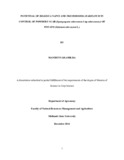Please use this identifier to cite or link to this item:
https://cris.library.msu.ac.zw//handle/11408/592| Title: | Potential of brassica napus and trichoderma harzianum in control of powdery scab (Spongospora subterranea f.sp.subterranea.) of potato (Solanum tuberosum L.) | Authors: | Manditsvara, Hilda | Keywords: | Potato production | Issue Date: | Dec-2014 | Publisher: | Midlands State University | Abstract: | Potato (Solanum tuberosum L.) is one of the most important crops grown in Zimbabwe owing to its nutritional and economic benefits. However, its production is often adversely affected by soilborne fungal pathogens such as Spongospora subterranea f.sp subterranea, the causal agent of powdery scab on potato tubers and the vector of Potato Mop Top Virus. The fungal pathogen forms root galls on roots and lesions on tubers. Brassica crops incorporated in crop rotations or applied as green manures have been associated with reduction in soilborne pathogens. Biological control of soilborne plant pathogens by the addition of antagonistic microorganisms to the soil such as Trichoderma spp. has also been suggested. In this study, two experiments were set up in a glasshouse with 340C (±3) and 210C (±3) day and night temperature respectively at Harare Research Station to determine the efficacy of B. napus and T. harzianumin controllingS. subterranea in potato. The first experiment was a 5 x 3 factorial in a CRD with three replications to investigate the effect of B. napus on the incidence and severity of powdery scab on potato. The first factor was B. napus at 10%, 20%, 30% rates with Mancozeb (positive control) and negative control where no control amendment was added. The second factor was potato variety and the levels were BP1, Diamond and Mondial. B. napus 20% reduced disease incidence by 31%, severity by 37% (root galls) and 67% (tubers). B. napus 20% on Mondial resulted inhigh proportion of 100% and 175% on marketable yield, extra-large and large tubers grade respectively compared to the positive control, Mancozeb on Mondial. The second experiment was a 5 x 3 factorial in a CRD with three replications to assess the effect of T. harzianum on the incidence and severity of powdery scab in potato. The first factor was T. harzianumrates were 1gl-1, 2g l-1 , 3g l-1 at 1 x 107CFUg-1with Mancozeb (positive control) and a negative control were no control amendment was applied. The second factor was potato variety and the levels were BP1, Diamond and Mondial.T. harzianum 1 x 107CFUg-1 2g l-1 reduced disease incidence by 26% and severity by 38% (root galls) and 59% (tubers). T. harzianum 1 x 107CFUg-1 2g l-1 on Mondial resulted in 343 % increase in proportion of extra-large tubers compared with the positive control, Mancozeb on Mondial. | URI: | http://hdl.handle.net/11408/592 |
| Appears in Collections: | Master of Science in Crop Science |
Files in This Item:
| File | Description | Size | Format | |
|---|---|---|---|---|
| FINAL DISSETATION HILDA.pdf | 661.72 kB | Adobe PDF |  View/Open |
Page view(s)
268
checked on Jan 18, 2026
Download(s)
172
checked on Jan 18, 2026
Google ScholarTM
Check
Items in MSUIR are protected by copyright, with all rights reserved, unless otherwise indicated.



